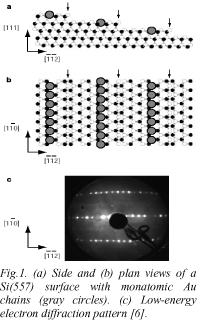| 
The
epitaxial growth of ultra-thin films on crystalline substrates and the
fabrication of nanostructures with atomic resolution will provide exciting,
qualitatively new research opportunities. In fact, this growth method
would allow the production of systems that can not be obtained through
conventional chemical processes.The main goal of this research project
is that of exploring new pathways for the fabrication of complex structures
with novel physical properties, which could have a great significance
from the point of view of technological innovations. For instance, we
would like to investigate whether a new class of magnetic systems can
be obtained by introducing dilute specific point defects in the crystal
structure of conventional materials, which could play an important role
in particular in the new field of spintronics [1].
For example, half-metallic ferromagnets could be obtained from simple
nonmagnetic band insulators such as CaO [2], and half-metallic antiferromagnets
from antiferromagnetic insulators such as NiO [3], which would all be
ideal materials for innovative spin-dependent electronics. In addition,
one-dimensional nanostructures will be also investigated with respect
to the possibility of creating nanowires that exhibit new interesting
physical phenomena. These nanostructures could be created on stepped
surfaces [4,5], as well as on substrates or films, with the help of
molecular beam epitaxy methods and/or atomic manipulation techniques
using an STM apparatus [6,7]. At last, it is worth emphasizing that
the epitaxial growth of thin films on crystalline substrates will also
be applied as a new approach to study the metal-insulator transition
in correlated metal such as CaVO3 [8]. By opportunely
choosing the film-substrate lattice mismatch, we can attempt to actively
tune fundamental parameters such as chemical bond angles and bond lengths
(and in turn the overlap integrals between the valence electrons), and
this way drive the system through the metal-insulator transition. |
 |
[1] S. A. Wolf et al., Science 294,
1488 (2001).
[2] I.S. Elfimov, S. Yunoki, G.A. Sawatzky, Phys. Rev. Lett. 89,
216403 (2002).
[3] D. Ködderitzsch et al., Phys. Rev. B 68,
125114 (2003) .
[4] P. Segovia et al., Nature 402, 504 (1999).
[5] R. Losio et al., Phys. Rev. Lett. 86, 4635
(2001).
[6] D.M. Eigler and E.K. Schweitzer, Nature 344, 524 (1990).
[7] K.-F. Braun and K.H. Rieder, Phys. Rev. Lett. 88,
096801 (2002).
[8] I. H. Inoue et al., Phys. Rev. Lett. 88,
236403 (2002).
|


